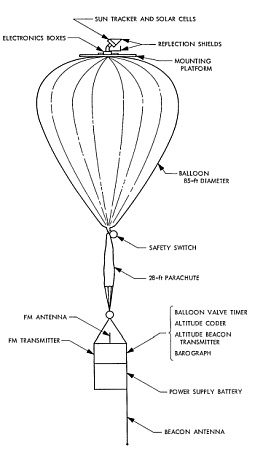Purpose of the flight and payload description
The purpose of the high altitude solar cell calibration program was to produce air mass zero (AM0) standard solar cells that could be used for accurately setting solar simulator intensities. The program was started in 1962 by the Jet Propulsion Laboratory of the California Institute of Technology in Pasadena and endured for more than 40 years.
Since the output of solar cells is spectrally selective, the electrical power derived from solar cells depends on the total intensity and the spectral distribution of the light source: the Sun. Attempts were made to procure a laboratory light source which has the same spectral character and intensity as the Sun. However, such attempts have been complicated as different types of radiation sensing devices, such as pyrheliometers and thermopiles, have been used which can not be accurately calibrated on either a total intensity or spectral intensity basis. To overcome this was introduced the concept of flying cells on a balloon, to measure their output at altitudes, to recover the cells and to use them as reference standards. The calibrated standard solar cell is placed in the solar simulator beam, and the beam intensity is adjusted until the standard solar cell reads the same as it reads on the balloon.
Althought some modifications were introduced over time, the main components of the balloon flight system were maintained along the entire program: a sun tracker, a helium-filled balloon, a telemetry system, and a battery power supply, as shown in the scheme at left (click for more detail). The sun tracker was mounted on the balloon apex, which is the most stable position of the balloon system. The telemetry transmitter and battery power supply, along with several instruments for measuring altitude, were suspended in a second gondola beneath the balloon. An electrical cable, incorporated into the balloon during manufacture, connected the top and bottom payloads.
The solar tracker was used to position the solar cell payload toward the sun, independent of balloon movements. The tracker was capable of movement in both elevation and azimuth to maintain an "on-sun" condition within +2 deg. A reflection shield attached to the solar tracker was used to prevent unwanted reflected light from reaching the solar cell payload. The tracker and associated electronics boxes were mounted on a plywood disk 6 ft in diameter, which, in turn, was bolted to the balloon top end fitting. The plywood disk permited the tracker to "float" on top of the helium bubble.
Details of the balloon flight

Balloon launched on: 7/29/1968 at 8:36 cdt
Launch site: University of Minnesota Airport, New Brighton, US
Balloon launched by: Litton Industries Inc.
Balloon manufacturer/size/composition: Zero Pressure Balloon SF-85.4-150-NS-06
Flight identification number: LITTON 3049
End of flight (L for landing time, W for last contact, otherwise termination time): 7/29/1968 at 19:20 CDT
Balloon flight duration (F: time at float only, otherwise total flight time in d:days / h:hours or m:minutes - ): 10 h 45 m
Landing site: 2 miles SE of Jackson, Winsconsin, US
The balloon was launched by dynamic method from the Litton Flight Facility located near New Brighton, Minnesota at 8:36 CDT on July 29, 1968 as Flight No. 3049. The balloon ascended on a southeasterly heading to a position 3 miles southwest of Plum City, Wisconsin, at an altitude of 70,000 feet. Then took a westerly heading from 10:00 to 11:40 CDT, reaching a float altitude of 82,800 feet. After a 1-hour period, the balloon began to lose altitude and took a north-northeasterly heading to a point 5 miles northeast of Ellsworth, Wisconsin, at 15:00 CDT, when the valve opened. From the time the valve opened at 66,200 feet until the safety timer terminated the flight, the system was on an east-southeasterly heading.
At 19:05 CDT, when the safety timer cut the balloon down, the system was over Ackerville, Wisconsin, at an altitude of 34,500 feet. The balloon and upper payload impacted in a cornfield 2 miles southeast of Jackson, Wisconsin, while the lower payload impacted in a cornfield 3 miles southwest of Cederburg, Wisconsin. There was only minor damage to the lower payload. The upper payload was recovered the following morning. The solar tracker was severely damaged by the free fall, but the solar cells appeared to be only slightly damaged.
The basic altitude instability problem on this flight was due entirely to the loss of earth heat radiation on the balloon because of the cloud cover between the balloon and the surface.
External references
- Results of the 1968 balloon flight solar cell standardization program Technical Report 32-1426, Jet Propulsion Laboratory, December 1, 1969
- Solar-tracker balloon flights 3048, 3049, and 3050 Final report (1968) Technical Report - Litton Systems, Inc.; Minneapolis, MN, United States
10321If you consider this website interesting or useful, you can help me to keep it up and running with a small donation to cover the operational costs. Just the equivalent of the price of a cup of coffee helps a lot.


